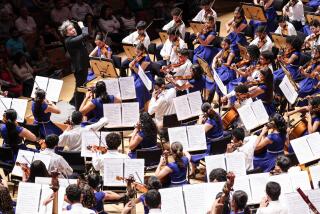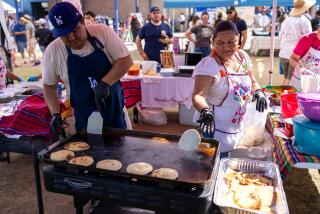No Disguising Joy of Carnaval
SANTA ANA — The fellow with the glittering grin and derby perched jauntily on his head who’s been welcoming visitors to the Bowers Museum lobby lately has an air that is more of the rogue than the relic.
Part of a lobby display promoting the museum’s upcoming touring show, “Con Mucha Alegria: Bolivian Festival Masks and Costumes,” this impish-looking character is actually a handmade tin mask, one of dozens of masks, costumes and noisemakers that will be on view in the exhibit opening Saturday.
And, although the show will provide an overview of traditional, quasi-religious celebrations such as the pre-Lenten carnaval, Bowers spokesman Brian Langston promises the environment will be as festive and inviting as the tin ambassador suggests.
After viewing the show, families are encouraged to visit the Bowers’ adjacent hands-on facility, Kidseum, to take part in mask-making workshops, storytelling and exhibits that complement the Bolivian show [see schedule below].
“We’re not hanging up these things and saying, ‘Look at this,’ ” explained Langston, of the exhibit’s child-friendly design. “We’re laying it out so visitors will feel like they’re one of the party-goers at carnaval. We want them to really get into the carnaval spirit.”
Festive Bolivian music will play in the gallery, which will be festooned with large color photographs of Bolivian parades and banners and flags like those that brighten the streets during these celebrations. A video documenting last year’s carnaval in Oruro, Bolivia, will be shown.
The collection is the work of guest curator Cynthia LeCount, a UC Davis instructor and artist who has been studying Bolivian arts and crafts for 25 years.
In her research, LeCount has focused primarily on the carnaval celebrations in the mountainous region of Oruro. The disfrazados (costumed ones), which can number into the thousands, are divided into three primary groups: the morenos, who represent the early African slaves who worked in the vineyards of Bolivia’s lowlands; the more lavishly dressed caporales, who depict their Spanish slave drivers (the mask mentioned earlier is that of a caporales); and the most flamboyant group, the diablas, who dress in brilliant reds and oranges and punctuate their intricate dances with smoke bombs so they appear to be dancing in the fires of hell.
Dancers often group themselves by job or school affiliation and carry noisemakers, or matracas, decorated accordingly (a bus drivers’ group, for example, may carry intricately painted tin buses).
Children can dance in the parades but because of the expense and the weight of the costumes and the arduous route of almost two miles, most of the dancers are teenagers and adults. It is high praise to say a dancer performs con mucha alegria (with much joy).
Accompanied by thousands of musicians along the way, the dancers ultimately convene at the Catholic church, where they kneel before the statue of the town’s patron saint, the Virgin of the Mineshaft (tin mining is one of the chief industries in Bolivia, which is more than 90% Catholic). Tradition has it that the Lady gives her benediction to those who promise to dance in the carnaval for three consecutive years.
“It’s a real point of pride to dance all the way to the church steps,” recalled LeCount, who has visited Oruro every year at carnaval time since 1980.
“It’s totally exhausting [because] the costumes and masks can weigh as much as 80 pounds, and they’re dancing on these cobblestone streets, sometimes in the rain and muck,” she said. “It’s not like the Rose Parade, where people are just sitting on floats.”
There are, LeCount added, some similarities between North American parades and carnaval. In Oruro, participants select a reina de carnaval and several senoritas de carnaval, the equivalent of a parade queen and her court.
Costumes and masks, which she says are more elaborate and detailed every year, are made by a select group of craftsmen and women who keep busy year-round preparing the pieces.
LeCount, who has published one book about Bolivian folk knitting, wrote her master’s thesis on these celebrations and is working on a book documenting the traditions and artistry behind them.
She says that, to her knowledge, her book and this exhibit (which visited the San Francisco Craft and Folk Art Museum in 1994) are the only extensive documentation of their kind. She’ll present a public program on her work and the exhibit Saturday at 2 p.m. at the Bowers.
“My whole emphasis in doing this is to give recognition to the artists who make this happen,” said LeCount, who says the same families have been involved in making the parade costumes for generations.
The masks and costumes “are not just an anonymous folk art; they’re done by real artists with names and faces and families.” Whenever possible, LeCount displays a photo of the artist alongside his or her work.
She speaks with pride about her personal relationships with these artists and dancers and hopes that her exhibit will help Western families gain a better appreciation of their culture.
“When I mention Bolivia here, most people say, ‘Isn’t that where Butch Cassidy went?’ ” LeCount recalled with a wry laugh. “That’s about all anybody seems to know about them, but they’re really a very open and warmhearted and talented people.”
* What: “Con Mucha Alegria: Bolivian Festival Masks and Costumes”
* When: Opens Saturday and continues through Aug. 18. Tuesday-Sunday, 10 a.m.-4 p.m., with extended hours on Thursday, 10 a.m.-9 p.m. Kidseum is open Wednesday-Friday, 2-5 p.m., Saturday-Sunday, 10 a.m.-4 p.m.
* Where: The Bowers Museum of Cultural Art, 2002 N. Main St., Santa Ana; Kidseum, 1802 N. Main St., Santa Ana.
* Whereabouts: Exit the Santa Ana (5) Freeway at Main Street; go south to the museum (parking adjacent on 20th Street).
* Wherewithal: $1.50-$4.50. Admission for Cynthia LeCount’s talk on June 1 is $5-$7.50.
* Where to call: (714) 567-3600.
More to Read
The biggest entertainment stories
Get our big stories about Hollywood, film, television, music, arts, culture and more right in your inbox as soon as they publish.
You may occasionally receive promotional content from the Los Angeles Times.










